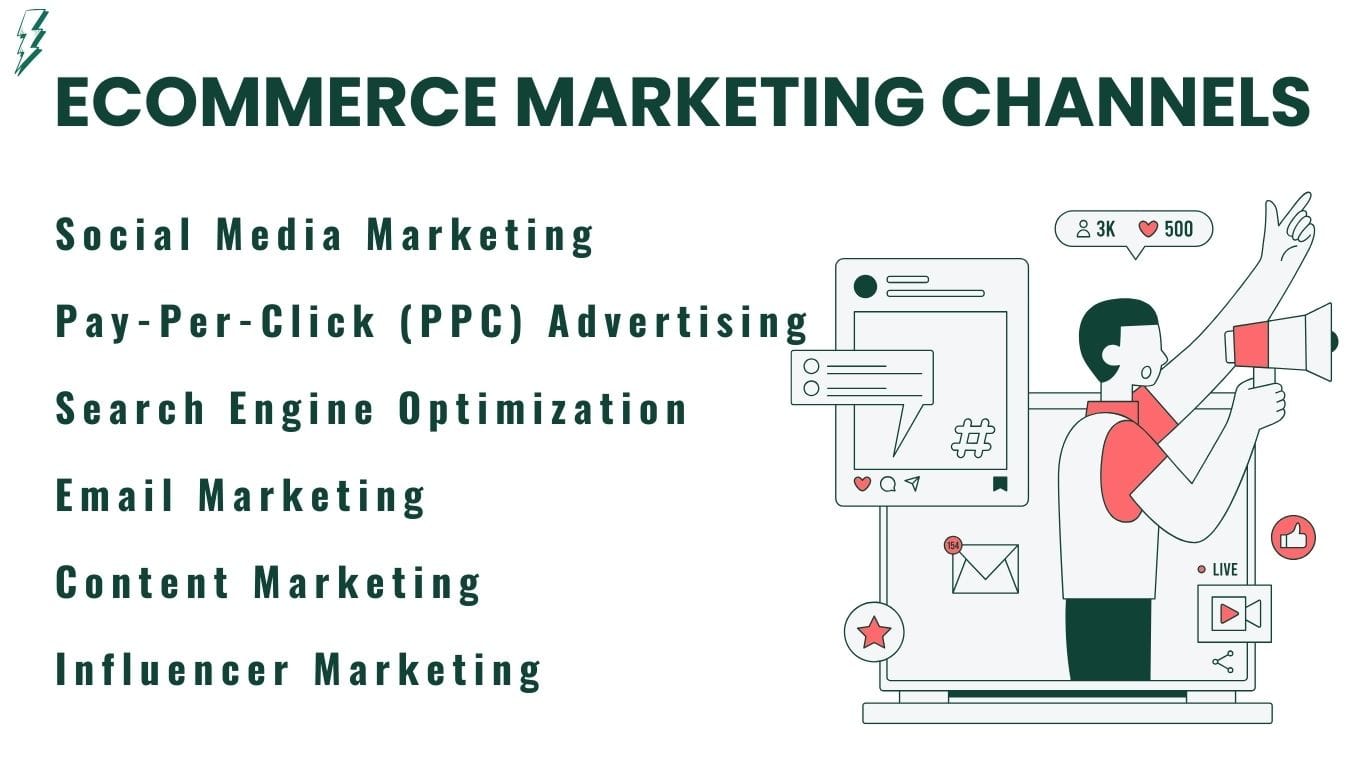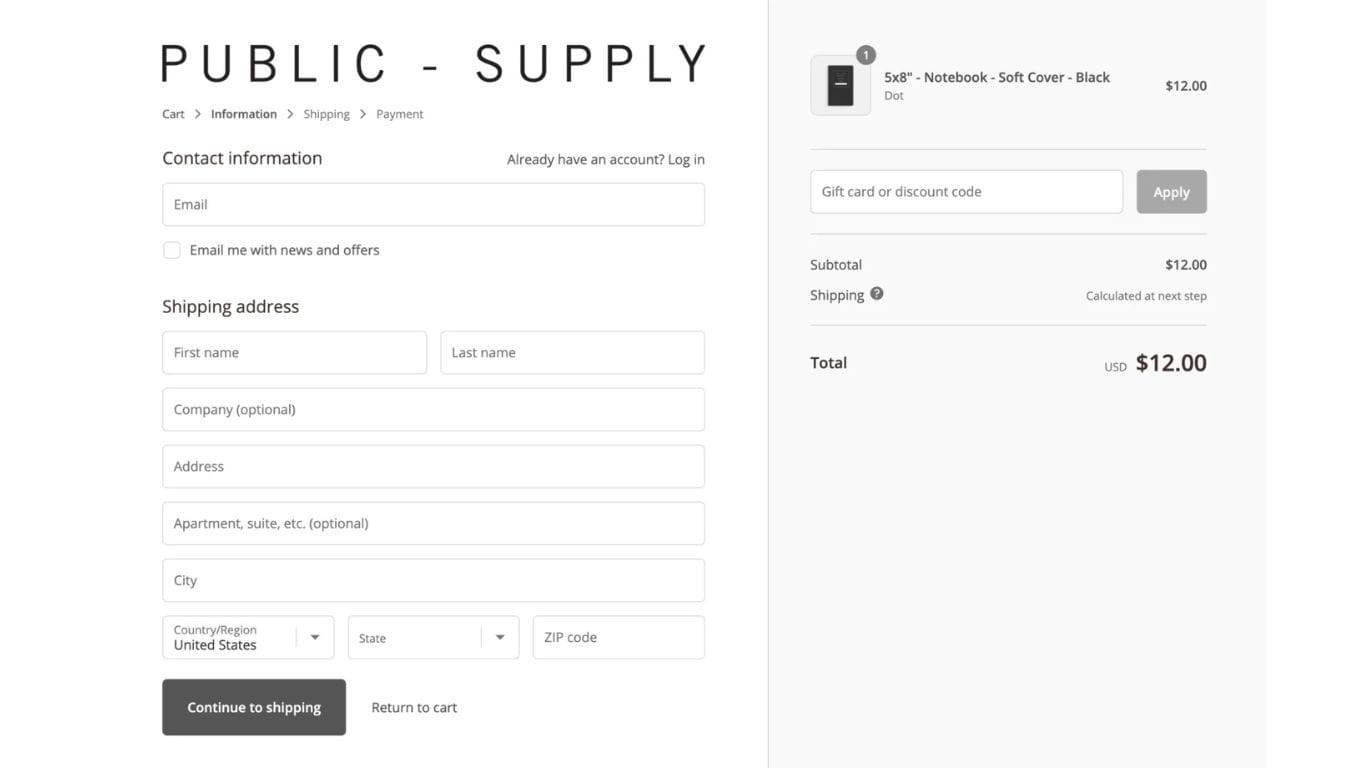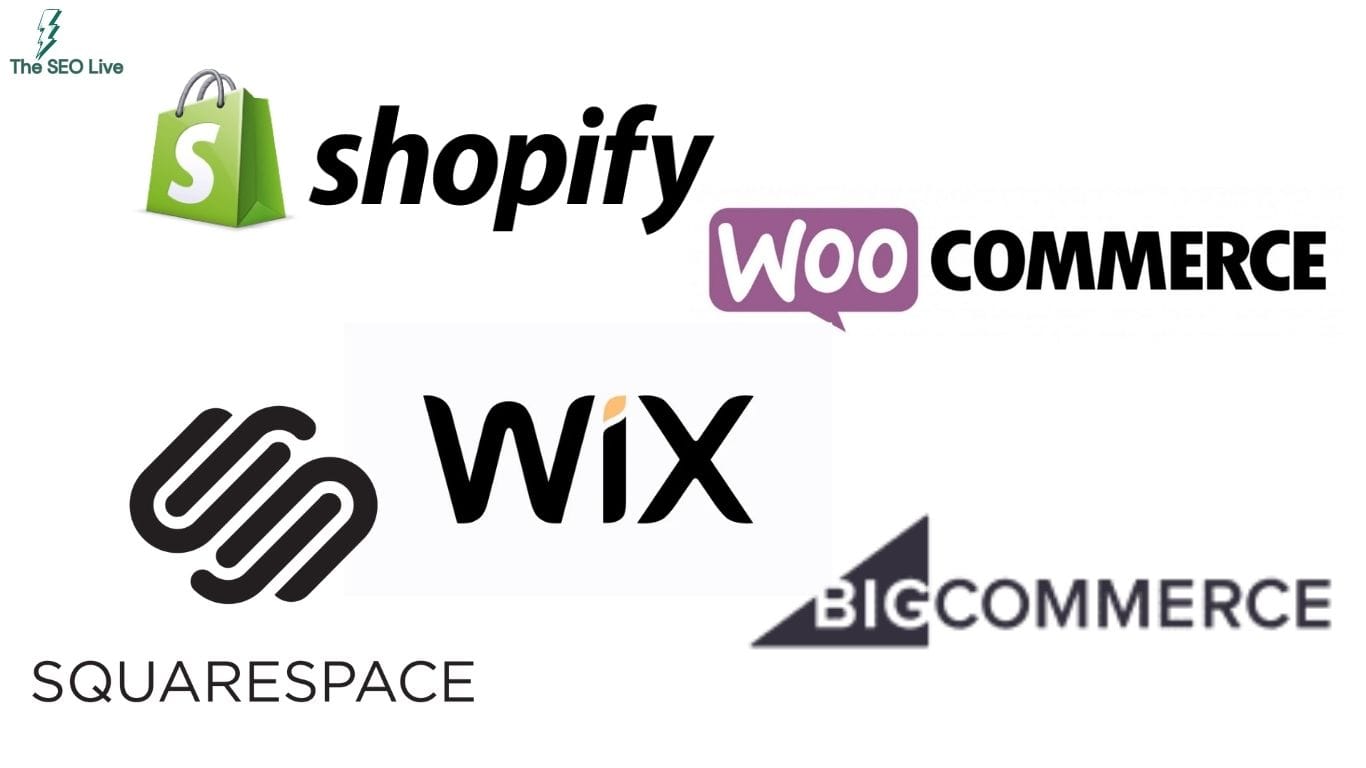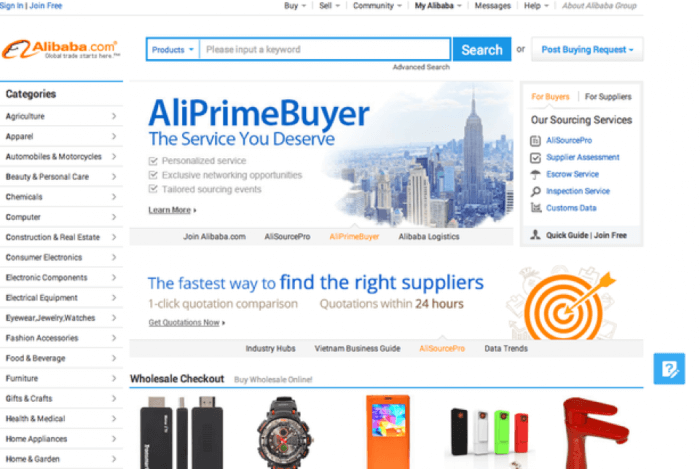Ecommerce market has transformed the retail landscape, making it easier than ever for businesses to reach global audiences. But standing out in a crowded marketplace can be challenging. To attract customers, build brand loyalty and ultimately drive sales, optimizing your online store is crucial.
This comprehensive guide will equip you with the essential tools and techniques to elevate your ecommerce business.
From optimizing your online store to crafting compelling marketing campaigns. We’ll delve into the key aspects of ecommerce marketing that will help you attract and retain customers, boost sales, and build a strong brand presence.
What is Ecommerce Marketing?
Ecommerce marketing is the process of promoting and selling products or services online on multiple channels. It involves a variety of strategies to attract customers, drive traffic to your website and convert visitors into buyers.

Most Common Ecommerce Marketing Channels
Ecommerce marketing channels are the various platforms and strategies used to promote and sell products or services online. By effectively utilizing these channels, ecommerce businesses can attract new customers, increase sales, and build brand loyalty.
Here are some of the most common ecommerce marketing channels
Search Engine Optimization (SEO)
SEO involves optimizing your website to rank higher in search engine results. This helps potential customers find your products or services when they search for relevant keywords.
By improving your website’s visibility, you can attract organic traffic and drive sales.
Pay-Per-Click (PPC) Advertising
PPC advertising allows you to bid on keywords and display ads on search engine results pages (SERPs) and other websites. When someone clicks on your ad, you pay a fee.
This channel is effective for quickly driving targeted traffic to your website and generating immediate sales.
Social Media Marketing
Social media platforms like Facebook, Instagram, Twitter, and TikTok offer a great opportunity to connect with your target audience.
By sharing engaging content, running promotions, and interacting with followers, you can build brand awareness, drive traffic to your website, and increase sales.
Email Marketing
Email marketing is a powerful tool for nurturing leads, promoting products, and encouraging repeat purchases. By sending targeted email campaigns, you can build relationships with your customers and drive conversions.
Content Marketing
Content marketing involves creating valuable content like blog posts, articles, and videos to attract and engage your target audience.
By providing helpful information, you can establish your brand as an authority in your industry and drive traffic to your website.
Influencer Marketing
Influencer marketing involves partnering with influential individuals in your industry to promote your products or services. By leveraging their audience, you can reach a wider audience and increase brand awareness.
Dropshipping vs. Inventory-Based Ecommerce: Which Ecommerce Solution is Right for You?
Dropshipping and inventory-based ecommerce are two primary models for running an online store.
Each has its own set of advantages and disadvantages.
Dropshipping

Low upfront cost: No need to invest in inventory.
Wide product range: Offer a diverse product catalog without the storage burden.
Less operational complexity: Simpler logistics and fulfillment.
Lower profit margins: Less control over pricing and shipping.
Dependency on suppliers: Reliance on third-party suppliers for product quality and timely delivery.
Limited brand control: Less control over packaging and customer experience.
Inventory-Based Ecommerce

Higher control over branding and customer experience: Direct control over product quality, packaging, and shipping.
Potential for higher profit margins: Greater control over pricing and shipping costs.
Stronger customer relationships: Direct interaction with customers, leading to increased loyalty.
Higher upfront costs: Investment in inventory and storage.
Increased operational complexity: Managing inventory, shipping, and returns.
Risk of inventory obsolescence: Potential for unsold inventory and associated costs.
Choosing the Right Ecommerce Solution
The optimal choice depends on various factors, including:
- Budget: Consider your initial investment and ongoing operational costs.
- Product niche: Assess the product category and its suitability for dropshipping or inventory-based models.
- Scalability: Evaluate your long-term growth plans and the scalability of each model.
- Risk tolerance: Assess your comfort level with potential risks and uncertainties.
By carefully considering these factors, you can select the ecommerce marketing solution that aligns with your business goals and resources.
How To Build A Successful Ecommerce Marketing Store


Create a User-Friendly Shopping Experience
Your online store is your virtual storefront, and the first impression matters.
Here’s how to create a user-friendly experience that keeps customers coming back.
Intuitive Navigation: Design a clear and simple navigation system that allows visitors to effortlessly find what they’re looking for. Consider using mega menus for extensive product categories.
High-Quality Product Images: Showcase your products with professional-looking, high-resolution images from multiple angles. Include zoom functionality for detailed product views.
Detailed Product Descriptions: Go beyond basic product descriptions. Provide in-depth information about features, benefits, specifications, and sizing guides.
Mobile Optimization: In today’s mobile-first world, ensure your online store is fully responsive and delivers a seamless shopping experience on all devices.
Embrace the Power of Content Marketing
Content marketing is a game-changer in ecommerce marketing.
Here’s how to leverage it to attract new customers and establish your brand as a thought leader.
Create Engaging Blog Content: Develop informative blog posts that address customer needs, answer common questions, and showcase your products in context. Consider incorporating video content for enhanced engagement.
Optimize for Search Engines (SEO): Conduct keyword research and optimize your website content and product pages for relevant search terms. This will improve your organic search ranking and drive qualified traffic.
Utilize Social Media Effectively: Integrate social media platforms like Facebook, Instagram, and Pinterest into your marketing strategy. Use high-quality visuals, customer reviews, and engaging captions to promote your products and build brand awareness.
Streamline the Checkout Process

A complex checkout process can lead to cart abandonment.
Here’s how to simplify and optimize your checkout flow
Offer Guest Checkout: Provide a guest checkout option alongside account creation for faster purchasing.
Multiple Payment Options: Offer a variety of secure payment options, including credit cards, debit cards, and popular online payment gateways like PayPal or Stripe.
Transparent Shipping Costs: Clearly display shipping costs upfront, without hidden fees. Consider offering free shipping options above a certain order value.
Live Chat Integration: Implement a live chat feature to address customer questions and concerns during the checkout process.
Build Trust and Credibility
Building trust is vital for online businesses. Here’s how to convince customers that your store is reliable and trustworthy:
Display Clear Return and Refund Policies: Ensure your return and refund policies are easily accessible and transparent. Offer a hassle-free return process to instill confidence in your customers.
Customer Reviews and Testimonials: Encourage customers to leave reviews and showcase positive testimonials on your website. This social proof instills trust and influences purchase decisions.
Security Seals and Certifications: Display security seals from trusted security providers to reassure customers that their financial information is secure.
Embrace Analytics and Data-Driven Decisions

Data is king in eCommerce. By analyzing data, you can gain valuable insights into customer behavior and optimize your store accordingly.
Track Website Traffic and Conversions: Utilize analytics platforms like Google Analytics to track website traffic, user behavior, and conversion rates.
A/B Test Different Elements: Run A/B tests to compare different versions of product pages, layouts, and calls to action. This helps identify what resonates best with your audience.
Monitor Customer Reviews: Actively read and respond to customer reviews. This demonstrates your commitment to customer satisfaction and helps improve your products and services.
Stay Ahead of the Curve
The eCommerce landscape is constantly evolving. Here’s how to stay informed and adapt to the latest trends:
Emerging Technologies: Embrace innovative technologies like voice search optimization and visual search to enhance the customer experience.
Mobile Commerce (mCommerce): Mobile shopping is on the rise. Continuously optimize your mobile store for a seamless user experience.
Personalized Marketing: Utilize data-driven insights to personalize product recommendations, email marketing campaigns, and website experiences. This fosters a stronger connection with your customers.
Also Check: Master Ecommerce SEO
Best Ecommerce Platforms for Small Businesses in 2025

Selecting the ideal ecommerce platform for your small business is crucial. Consider factors like budget, technical expertise, and desired features.
Popular options include Shopify, WooCommerce, BigCommerce, and Squarespace.
Shopify offers user-friendliness and a wide range of apps, while WooCommerce provides flexibility and customization.
BigCommerce excels in scalability and advanced features, and Squarespace prioritizes design and ease of use. Ultimately, the best ecommerce platform for you depends on your specific business needs and goals.
Choosing the right ecommerce platform is crucial for small businesses to establish a strong online presence and drive sales.
Here are some of the top ecommerce platforms tailored for small businesses in 2025
1. Shopify
- User-friendly interface
- Extensive app store
- Strong SEO capabilities
- Reliable customer support
2. WooCommerce
- Highly customizable
- Open-source platform
- Integrates seamlessly with WordPress
- Ideal for tech-savvy entrepreneurs
3. BigCommerce
- Powerful features for scaling businesses
- High-performance platform
- Advanced SEO tools
- Excellent customer support
4. Squarespace
- Beautiful templates for visually appealing stores
- Easy-to-use interface
- Strong focus on design and branding
- Suitable for smaller businesses with simpler needs
5. Wix
- Drag-and-drop website builder
- Suitable for beginners
- Limited customization options compared to others
- Best for small businesses with basic needs
Key Factors to Consider
- Budget: Consider the initial setup costs, monthly fees, and transaction fees.
- Scalability: Choose a platform that can grow with your business.
- Ease of Use: A user-friendly interface can save you time and effort.
- Features: Look for features like payment gateways, shipping options, and marketing tools.
- SEO: Strong SEO capabilities can help you rank higher in search engine results.
- Customer Support: Reliable customer support is crucial for resolving issues.
By carefully evaluating these factors and considering your specific business needs, you can select the best ecommerce platform to propel your online business to new heights.
Ecommerce Platform Marketing Strategies for 2025
In 2025, ecommerce platforms will continue to evolve, driven by technological advancements and changing consumer behaviors. To thrive in this dynamic landscape, consider these ecommerce marketing strategies.
1. Personalized Shopping Experiences
- Leverage AI and Machine Learning: Utilize AI-powered algorithms to analyze customer data and deliver tailored product recommendations.
- Implement Dynamic Pricing: Adjust prices in real-time based on factors like inventory levels, customer behavior, and market trends.
2. Social Commerce
- Partner with Influencers: Collaborate with influencers to promote products and reach a wider audience.
- Integrate Social Media Buying: Enable direct purchases from social media platforms like Instagram and TikTok.
3. Voice Commerce
- Optimize Product Listings for Voice Search: Ensure your products appear in voice search results by using relevant keywords and phrases.
- Develop Voice-First Experiences: Create voice-activated shopping experiences through smart speakers and voice assistants.
4. Augmented Reality (AR) and Virtual Reality (VR)
- Offer Virtual Try-On Experiences: Allow customers to virtually try on products like clothing and accessories.
- Create Immersive Shopping Environments: Use VR to transport customers to virtual stores and product showcases.
5. Sustainable and Ethical Marketing
- Highlight Sustainability Efforts: Promote eco-friendly products and sustainable practices to attract environmentally conscious consumers.
- Support Social Causes: Partner with charitable organizations and donate a portion of your proceeds to social causes.
By embracing these strategies, ecommerce platforms can enhance customer engagement, drive sales, and build lasting brand loyalty in the competitive digital marketplace.
Ecommerce Marketing Solution Trends: Navigating the Digital Landscape
The ecommerce marketing landscape is constantly evolving. Driven by technological advancements and changing consumer behaviors. To stay competitive, businesses must adapt to emerging trends and adopt innovative ecommerce marketing solutions.
Key Ecommerce Marketing Trends to Watch:
AI-Powered Personalization: Leveraging AI to tailor product recommendations, marketing campaigns, and customer experiences.
Voice Commerce: Optimizing for voice search and voice assistants to capture a growing segment of online shoppers.
Augmented Reality (AR) and Virtual Reality (VR): Enhancing the shopping experience with immersive AR and VR technologies.
Sustainable Ecommerce: Adopting eco-friendly practices and transparent supply chains to appeal to environmentally conscious consumers.
Mobile Commerce: Continuing to optimize for mobile devices, including mobile-friendly websites and mobile apps.
Social Commerce: Integrating e-commerce functionalities into social media platforms to drive sales.
By staying informed about these trends and implementing effective ecommerce marketing solutions, businesses can thrive in the digital age.
Ecommerce Solutions for B2B Businesses
E-commerce solutions empower B2B businesses to streamline operations, expand their reach, and enhance customer experiences. By leveraging advanced e-commerce platforms, businesses can automate order processing, manage inventory efficiently, and provide real-time customer support.

Key Features of B2B Ecommerce Solutions
Product Catalog Management: Organize and categorize a vast product catalog, including detailed specifications and pricing information.
Customizable Storefront: Design a branded storefront that reflects your business identity and offers a seamless user experience.
Secure Payment Gateways: Integrate multiple payment options to accommodate diverse customer preferences and ensure secure transactions.
Inventory Management: Track inventory levels in real-time, automate reordering processes, and optimize stock management.
Order Management: Streamline order processing, fulfillment, and shipping, ensuring timely delivery and customer satisfaction.
CRM Integration: Integrate with CRM systems to manage customer relationships, track sales history, and personalize interactions.
Advanced Analytics: Gain valuable insights into customer behavior, sales trends, and product performance to make data-driven decisions.
By implementing a robust ecommerce solution, B2B businesses can increase sales, improve customer satisfaction and achieve long-term growth.
Final Words
By implementing these eCommerce marketing tips and tricks, you can optimize your online store for success. Remember, continuous improvement is key. Stay up-to-date with industry trends, analyze your data and adapt your strategies to meet the evolving needs of your customers.

